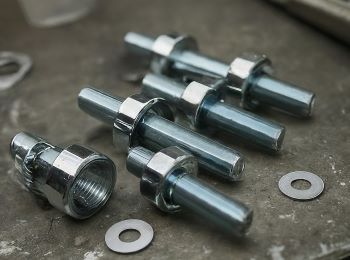Metric banjo fittings are a workhorse in the world of fluid transfer systems. They might seem simple, but these fittings offer a reliable and versatile solution for a wide range of applications.
This guide dives deep into metric banjo fittings. It explores their anatomy, uses, selection factors, and proper installation.
Anatomy of a Metric Banjo Fitting
Imagine a metric banjo fitting like a tiny team working together to ensure smooth fluid flow. Here are the key players:
Bolt: This is the core of the fitting, featuring metric threads for secure attachment.
Banjo Body: Shaped like a half-moon, the banjo body houses the sealing washer and connects to the tubing or hose.
Sealing Washer (or Crush Washer): This compressible washer creates a tight seal between the banjo body and the mating surface.
Optional Features: Some metric banjo fittings may include a swivel nut for added adjustability or a banjo plug for closing off a port.
Applications of Metric Banjo Fittings
Metric banjo fittings are a popular choice across various industries due to their compact size, secure sealing, and ease of use. Here are some common applications:
Automotive: Fuel injection systems, hydraulic lines for brakes and power steering.
Industrial Machinery: Lubrication systems for bearings and gears, coolant lines for temperature control.
Medical Equipment: Fluid transfer in diagnostic machines and laboratory equipment.
Heating and Cooling Systems: Condensate lines in air conditioning units and boilers.
Their compact size makes them ideal for tight spaces, while the secure sealing ensures leak-free performance. Additionally, the ease of assembly and disassembly allows for quick maintenance and repairs.
Selection Factors for Metric Banjo Fittings
Choosing the right metric banjo fitting requires considering a few key factors:
Size: This includes both the thread diameter (in millimeters) and the banjo body size. It’s crucial to ensure the thread size matches your system’s metric threads for a proper fit.
Material: Metric banjo fittings come in various materials like brass, steel, and stainless steel. Brass offers good corrosion resistance for general applications. Steel provides higher strength for high-pressure systems, while stainless steel offers superior corrosion resistance for demanding environments.
Working Pressure: Select a fitting with a pressure rating exceeding the maximum operating pressure of your system. This ensures the fitting can handle the workload safely.
Size, material, and pressure are the main factors. Flow rate and fitting style (straight, elbow, etc.) might also matter, depending on your application.
Installation Tips for Metric Banjo Fittings
Installing metric banjo fittings is simple. But, you need the right technique. It’s key for a secure, leak-free connection. Here’s a basic overview (consult the manufacturer’s instructions for specific details):
-
Preparation: Clean and inspect all components for any damage or debris.
-
Sealant (Optional): Some applications might require applying a thread sealant to the bolt threads for additional leak prevention.
-
Tightening: Use a torque wrench to tighten the bolt to the manufacturer’s recommended torque specifications. Overtightening can damage the fitting, while under-tightening can lead to leaks.
Follow these steps. Also, follow the manufacturer’s instructions. Doing so ensures a safe and reliable installation of your metric banjo fittings.
Conclusion
Banjo fittings use the metric system. They offer a simple solution for many fluid transfer jobs. Understanding their parts, uses, how to choose them, and how to install them lets you make informed choices for your needs.
Metric banjo fittings are small and seal well. They are a versatile and reliable choice for many fluid systems.
Post time: May-18-2024


